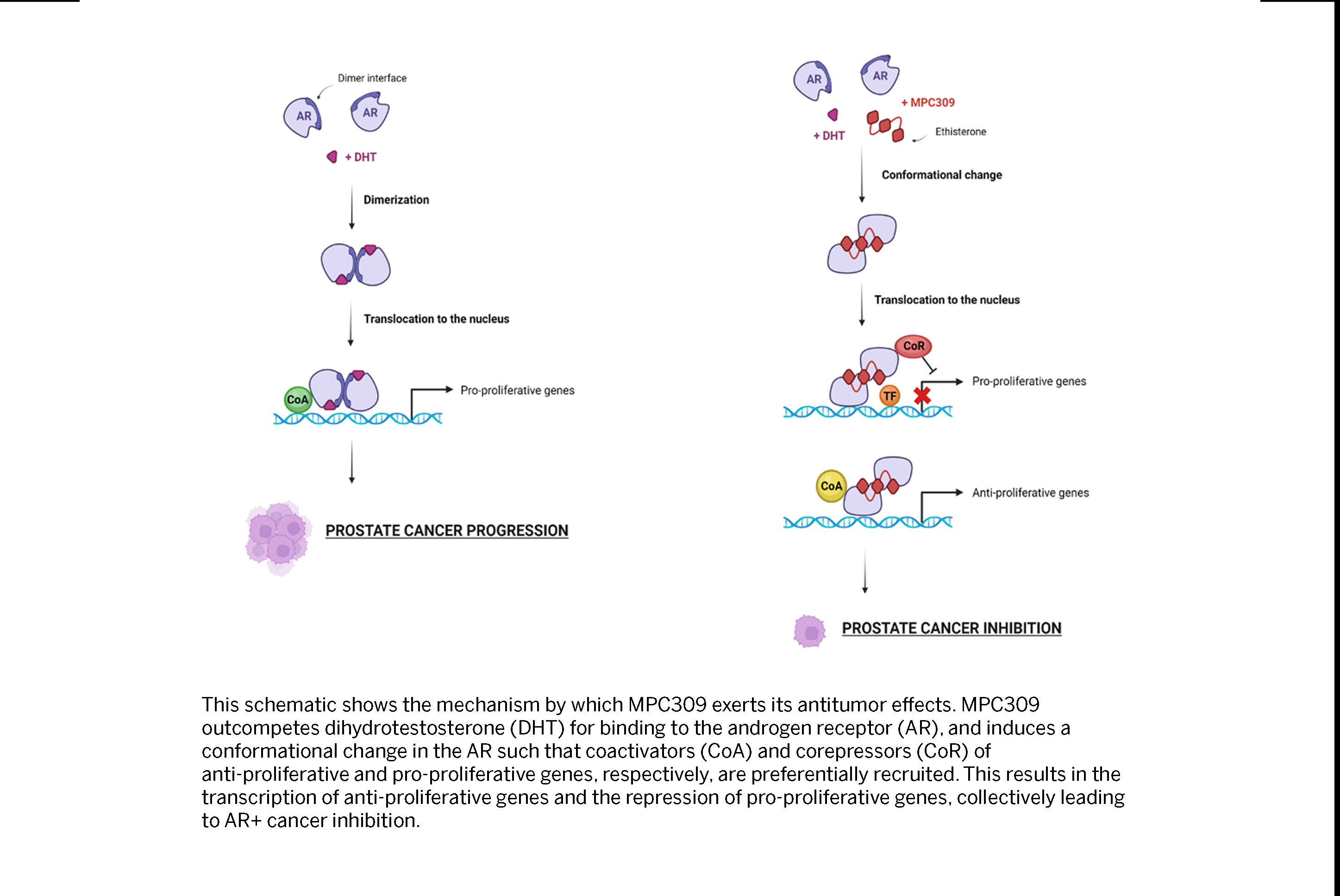Multivalent Steroid Conjugates for Treatment of Castration-Resistant Prostate Cancer (CRPC)
A new generation of therapeutics for treating patients with enzalutamide-resistant CRPC.

Technology
The NYU inventors have developed a novel class of chemical agents to inhibit the androgen receptor (AR) for the treatment of castration-resistant prostate cancer (CRPC). These novel agents are multivalent peptidomimetic molecules. The molecular backbone comprises synthetic “peptoid” oligomers conjugated to ethisterone ligands that are capable of binding to the AR. The conjugates potently engage with AR and alter the expression of AR target genes. Peptoids are a promising family of synthetic peptide analogs in which the position of the side chain groups is altered. One significant advantage peptoids confer over peptides is their resistance to proteolytic cleavage. This leads to significantly enhanced stability and, consequently, more favorable DMPK profiles. In proof-of-concept experiments (Habault et al. Mol Cancer Ther 2023), the inventors identified a lead conjugate, termed “MPC309”, capable of potently and selectively inhibiting the proliferation of androgen receptor (AR+) CRPC cell lines that are androgen-independent and resistant to enzalutamide via AR overexpression, AR ligand binding mutations, or AR variants in in vitro and in vivo models. MPC309 was found to enhance the expression of an anti-proliferative transcriptional program upon AR binding, thereby reducing the expression of genes that drive cell division and metabolism. Mechanistically, MPC309 functions to repress such gene programs by modifying the conformation of the AR to alter its recruitment of cofactors (see schematic on next page). Because MPC309, and more generally this class of conjugates, carries a unique mechanism of action, drug resistance mechanisms commonly encountered for current AR-targeting therapies (e.g., enzalutamide) will likely be mitigated or avoided. Additionally, MPC309 has been shown to be taken up by cells through macropinocytosis, an endocytic process commonly found in transformed cells, resulting in its preferential delivery to tumor cells. This uptake mechanism will limit the types of systemic toxicities established by current (enzalutamide/apalutamide) and future (AR-degraders) AR-targeted therapies. Altogether, MPC309 is a promising preclinical therapeutic candidate for CRPC treatment.
Background
Prostate cancer is among the most commonly diagnosed forms of cancer. Roughly 290,000 people were diagnosed with prostate cancer in the U.S. in 2023. The prostate cancer therapeutic space is expected to reach a market size of $28.5 billion by 2032 at a CAGR of 8.4%. Early-stage prostate cancers are typically classified as “androgen-dependent” and require androgens to grow. Androgen deprivation therapies (ADT), which reduce androgen levels or block the action of androgens, are used as frontline therapies for males with advanced prostate cancer. Although ADT is initially effective in 80-90% of patients, relapse is nearly universal. These relapsed tumors are classified as “androgen-independent” but have been shown to be still driven by AR signaling. In order to evade ADT, these tumors upregulate AR expression, enabling them to be sustained by low levels of adrenal steroids. Paradoxically, antiandrogen molecules, such as enzalutamide/apalutamide (AR antagonists), also face drug resistance from tumors by the upregulation of AR signaling via AR amplification, AR ligand binding domain mutations, and AR variants. Thus, these tumors become unresponsive to such therapies. Inhibition of AR function by novel mechanisms that bypass these common resistance pathways will likely provide therapeutic benefits to patients with advanced CRPC.
Applications
- Therapeutic: Treatment of AR+ CRPC and possible treatment of AR+ breast cancer.
- Research Tool: To investigate AR signaling pathways in vitro and in vivo in the context of cancer.
Advantages
- Highly modifiable affinity and specificity: The number of functional ligands on the peptoid backbone can be tailored per application.
- Cost-effective and efficient synthesis: Conjugates can be generated by cell-free methods efficiently. Scale-up GMP production is straightforward.
- Tumor-preferential targeting: Conjugates exploit enhanced macropinocytosis in transformed cells for selective delivery.
- Superior stability: The peptoid backbone of conjugates is resistant to proteolytic cleavage and enzymatic degradation.
- Advantageous pharmacokinetics: Conjugates possess good aqueous solubility and improved cell permeability over peptides.
- A new chemical landscape: Peptoid conjugates comprise a novel chemical space that combines the best features of small molecules and protein biologics to modulate protein interactions and achieve therapeutic efficacy.
Development Status
The inventors are working to optimize the lead conjugate's potency, pharmacological properties, and mode of delivery.
Intellectual Property
- Issued U.S patent (US11766480) covering the composition of the peptoid conjugates and the method of use thereof as androgen receptor modulators for the treatment of human cancer (NYU internal ref. KIR01-10US).
- Issued U.S. patents (US8524663 and US9107959) covering the composition of a novel polyvalent display platform for peptidomimetics and the method of making the same (NYU internal ref. KIR01-03US and KIR01-03DIV)